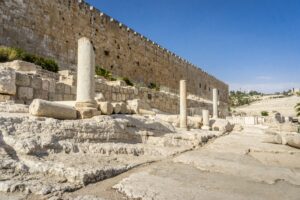Jerusalem is a holy city for three religions: Judaism, Christianity and Islam, in this regard, I decided to write an article about all the historical places known to me in Jerusalem for three monotonic religions.
The Historical Landmarks In Jerusalem
Jerusalem is one of the most beautiful cities in the world, also because of its very ancient history, and it is a significant centre of the three major monotheistic religions for many centuries. Jerusalem is the heart of Israel/Judaism and the place where the First Temple was built to keep the Ark of the Covenant protected. Moreover, in Christianity, Jerusalem is the holy location where Jesus had been crucified, and in Islam, the place where the Prophet Muhammad ascended to heaven. For many centuries, Jerusalem had been the traditional destination of pilgrimage, being one of the holiest cities in the world.
The following list includes the top historical places in Jerusalem, and it takes at least a week to visit all of them, besides being strongly recommended to plan the tour in advance.
The Temple Mount – Haram Al-Sharif
The Temple Mount – Haram Al-Sharif is one of the holiest shrines in the world, and it is the site where Abraham, who was the father of the three main monotheistic religions, offered his son to God as a sacrifice. Moreover, it is the holy place where Solomon built the First Temple to keep the Ark of Covenant safe and where the Prophet Muhammad ascended to heaven.

The majestic plaza is centred around the shining Dome of the Rock, and it is right above the Old City. Indeed, this is the sacred place for both Jews and Muslims, being the holy stone beneath the golden dome. In the southern area of the mount, there is the Al-Aqsa Mosque, which is the oldest mosque in the world.
The Western Wall – Kotel And The Jewish Quarter
The Western Wall – Kotel is the remnant of the boundary wall of Jerusalem’s First Temple. It is also well-known as Wailing Wall because it is the holy place where people cry while praying or talking to God, besides lamenting the destruction of the Temple in AD 70. The Kotel is the most sacred place for Jews, and it is the pilgrimage destination for the Jewish people since the Ottoman domination.
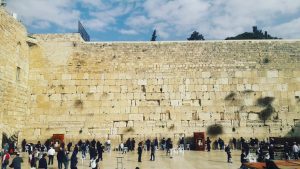
The Old City’s Jewish Quarter starts from Zion Gate in the eastern area of the Western Wall Plaza, which was destroyed in the Israeli-Arab conflict in 1948 and reconstructed in 1967.

Another landmark of this area is the Jerusalem Archaeological Park in the southern area of the Western Wall Plaza, where archaeologists found historical remnants of ancient Jerusalem.
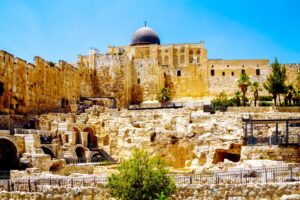
The Western Wall Tunnels are another important site underneath the Western Wall and including authentic historical parts of the original city. The Jewish Quarter Street is also well-known as Rehov HaYehudim, and it is the main route of this district. Around this main street, there are several side streets with a group of ancient synagogues.

The Armenian Quarter
The Armenian Quarter extends from the southern part close to the Citadel, and its main street is Armenian Patriarchate Road. It is a tiny district of the Old City of Jerusalem, and in the narrow streets, there are the St. James Cathedral and St. Mark’s Chapel. The Armenian community had been part of the Jerusalem community for several centuries since the first Armenians arrived in Jerusalem in the 5th century. The Armenian Quarter is the quietest district of the Old City, and it is a beautiful place to explore in a calm atmosphere.

The Christian Quarter of Jerusalem Old City
The Christian Quarter of Jerusalem Old City start from the Jaffa Gate and is gathered around the Church of the Holy Sepulchre. The Old City’s most popular tourist souvenir shops are inside a knot of very ancient alleyways, where there is a set of churches that deserve to be visited.
The Protestant Christ Church
The Protestant Christ Church in Omar ibn al-Khattab Square is a fascinating church with a fascinating museum displaying historical documents. Close to the church, there is a lovely café to relax while sipping a good coffee.
The Ethiopian Monastery
Another fantastic place that deserves attention is the Ethiopian Monastery, which is located in the corner of The Church of the Holy Sepulchre. The Ethiopian Monastery has impressive frescoes portraying the visit of the Queen of Sheba in Jerusalem.
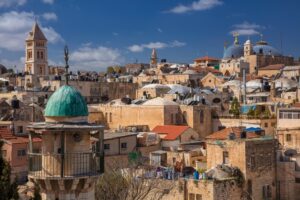
Another unique place of the Christian Quarter is the Lutheran Church of the Redeemer in Muristan Road had a beautiful bell tower with an incredible Old City view. Another landmark of the Christian Quarter is the Church of St. John the Baptist, which is close to Christian Quarter Street, and it is Jerusalem’s oldest church.
The Route Of The Via Dolorosa
The Route Of The Via Dolorosa is the Way of Sorrow, and for Christianity, it is a must-visit place in Jerusalem. This path tracks the route of Jesus Christ after his conviction while he carries his cross towards execution at Calvary. The walk is trailed independently, but joining the procession along this route driven by the Italian Franciscan monks is also possible on Fridays. The fourteen Stations of the Cross characterize the path of the Via Dolorosa. Some of these stations are in accordance with the Gospels’ stories, and others follow traditions.

The circuit starts in the Muslim Quarter of the Old City on Via Dolorosa Street, which is the first station, close to the intersection with HaPrakhim Street, wherefrom it is possible to follow the route west through eight stations until the 9th station at the Church of the Holy Sepulchre, where the last five stations take place. The modern street extends for about 600 meters. It has been the preferred path since the 18th century, replacing the oldest processional pathways that Christian pilgrims used to reach the Old City starting from the 8th century.
The Church Of The Holy Sepulchre
The Church Of The Holy Sepulchre in Christianity represents the holiest place in Jerusalem, and it is believed to be the site where Jesus was crucified. This sacred place was selected by Saint Helena, who was the mother of Constantine the Great, as the best place to build this church when she visited the Holy Land. Saint Helena announced to the Byzantine people that this place was the Calvary or Golgotha of the gospels. The first church was built in AD 335 and demolished in 1009, and the present church was rebuilt in the 11th century. It is the pilgrimage destination of the entire Christian world, and its interior architecture is opulent and beautiful. The church is the last point of the Via Dolorosa pilgrimage, and inside of it, the last five Stations of the Cross take place. Inside the Church of the Holy Sepulchre, there are many holy relics, and the rooms inside the church belong to different Christian religious groups.

King Herod had erected the Citadel – The Tower Of David
King Herod had erected the Citadel – The Tower Of David with the purpose to protect the palace that he built in 24 BC. Initially, the Citadel included three towers, and after Titus conquested Jerusalem in AD 70, the Romans placed one of their stations in the Tower of David. Hereafter, the Citadel deteriorated and was rebuilt by the Crusaders, the Mamelukes from Egypt and the Turks throughout their dominations in Jerusalem. The actual Citadel aspect dates back to the 14th restoration on the foundations of the ancient Phasael Tower.
The Tower of David hosts a museum, which displays the history of the city of Jerusalem with a permanent archaeological exhibition. Additionally, sometimes there are temporary exhibitions that show some cultural aspects of the Jerusalem historical heritage. On the rooftop of the Citadel, there is one of the most stunning and breathtaking views of the Old City of Jerusalem. In the evenings, sometimes in the year, there is a Sound and Light show, with beautiful images projected on the city walls.
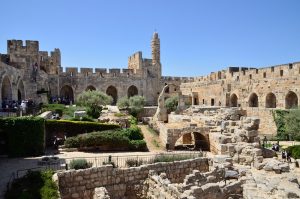
The Muslim Quarter
The Muslim Quarter is the most hectic of all the four quarters of the Old City of Jerusalem, and it hosts a great market, which is a very ancient souk and the best in the Old City.
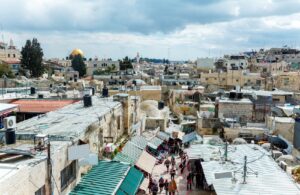
This district starts in Damascus Gate, and it extends until the northern area of the Old City. The Muslim Quarter is full of archaeological remnants along the street, which are featured by Mamluk architecture, such as the 14th century Khan al-Sultan in Bab al-Silsila Street, whose roof has breathtaking views across the chaotic alleyways.
The Mount Of Olives
The Mount Of Olives is crowded with churches, and it hosts the oldest cemetery that is still in use. The Mount of Olives represents a very significant and holy place for Christian religious pilgrims who visit Jerusalem. Nevertheless, the not religious visitors can also admire the magnificent Old City sceneries from the top of the mount. This holy hill is considered to be the place where God will resurrect the dead on Judgement Day. For Christian devotees, this is also the mount where Jesus rose to heaven after his crucifixion and resurrection. The Ascension Church, which is on the top of the peak, dates back to 1910, and it has the best prospects over Jerusalem.

Strolling downhill, there is a special place worth visiting, which is the Church of the Pater Noster had been built close to the site where Jesus instructed his disciples, according to the Christian tradition. Farther below, there is another church well-known as the Church of Dominus Flevit, which had been built above the place where Jesus mourned for Jerusalem. Further forward, it is located the onion-domed Russian Church of Mary Magdalene. Moreover, the Gardens of Gethsemane, where Jesus was arrested, and the Church of All Nations are nearby, together with the Tomb of the Virgin Mary, which is another renowned Christian landmark on the Mount of Olives.
Mount Zion
Mount Zion is the little hill that is located in the south of the Old City’s Zion Gate. In Judaism, Mount Zion is essential because it is the place of King David’s Tomb.

Going up through the stairs that are in the tomb’s courtyard, there is the Last Supper Room – here was the last meal of Jesus with his disciples. This place had been both a church and a mosque for many centuries.
The Old City Walls
The Old City Walls had been built as the Old City fortifications, and they date back to the Ottoman period. There are nine majestic gates inside the wall’s extension, which lead to the Old City.
The Damascus Gate is one of the most renowned gates of Jerusalem’s Old City, and Lions’ Gate, which is also named St. Stephen’s Gate, leads to the Mount of Olives outside the Old City’s walls. Zion Gate is the main entrance inside the Jewish Quarter, whilst Jaffa Gate is the principal gate to the Christian Quarter.
The wall ramparts are a beautiful trail to explore in the Old City. The two sections of the wall ramparts that can be toured are the pathway from Jaffa Gate until the northern part close to Lion’s Gate and the path going from Jaffa Gate up to the southern area close to Dung Gate.

East Jerusalem
East Jerusalem is outside the Old City’s Damascus Gate in the original Arab neighbourhood of East Jerusalem. In the eastern area outside the gate, inside the gardens at the base of the wall, there is a well-known cave as Solomon’s Quarries, which is located under the Old City. According to an ancient tradition, the stone employed to build Jerusalem’s First Temple was extracted from this cave, also known as Zedekiah’s Grotto.
Indeed, in Jewish tradition, Zedekiah had been the last king of Judah, and he hid in this cave to flee from the Babylonian armies in 587 BC.
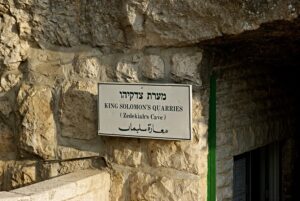
Walking towards the eastern side of the cave, along Sultan Suleiman Street, the Rockefeller Archaeological Museum exhibits historical remnants dating back to the Stone Age until the 18th century.

Walking towards Nablus Road, there is the Garden Tomb, which dates back to the Roman or Byzantine period, and it was discovered by General Gordon in 1882 and recognised as Christ’s tomb. Some Protestant Christians believe that this is the location of the burial of Christ.
Going to the northern direction, along Nablus Road, there is the French Dominican Monastery of St. Stephen, where the first Christian martyr is believed to have been stoned to death.
Turning into George Street, there is the Mandelbaum Gate, which was the only frontier crossing-point between the Israeli and Jordanian areas of Jerusalem between 1948 and 1967. The site is labelled with a plaque. Moreover, on St. George Street, there is the Museum on the Seam, a one-of-a-kind contemporary art museum in all of Israel that exhibits artworks about human rights.
Jerusalem Historical Central Sites
Jerusalem Historical Central Sites are in the centre of Jerusalem and it is easily possible to visit them, walking from the Old City’s Jaffa Gate, entering Jerusalem’s modern central city district with the long Jaffa Road, which stretches northwest to Safra Square.
The Russian Compound in Jerusalem
Northeast in Safra Square, located the Russian Compound. This area was built in the 19th century as a great walled neighbourhood for the Russian pilgrims, and in the northeast side of the building complex, there were the Russian consulate and a hospice for women; In the southwest, a hospital, the mission house, and a big hospice for men were located. Nowadays, several government institutions are located inside those buildings.

The Ethiopian Church
On Ethiopia Street, is situated the Ethiopian Church. The decorations with lions above the doorway evoke the style of Lion of Judah had been carried by the Abyssinian dynasty, which finds its origins in the Queen of Sheba.
Mea Shearim
Heading north from Ethiopia Street, there is the Mea Shearim district, which is the central district of the ultra-orthodox Jewish community. In Mea Shearim, it is mandatory to wear modest clothes, covering arms and legs.

Museum of Italian Jewish Art & Synagogue
In Hillel Street, there is the Museum of Italian Jewish Art & Synagogue, with a great collection of Judaica.
Ben Yehuda Street
Ben Yehuda Street is the central attraction of downtown Jerusalem where there is a vast choice of eateries to dine and many stores excellent for shopping.

The Israel Museum
The Israel Museum officially opened in 1965, and it is a complex of different museums. Indeed, it is the only place in Israel with the most extensive archaeological remnants and art collections. The most remarkable collection includes some precious and unique historical relics, such as the Shrine of the Book, which is the only portion of the Dead Sea Scrolls belonging to Israel since its discovery in the Dead Sea area in the 1940s. Meanwhile, the rest of the scrolls are displayed in Amman’s Citadel Hill museum in Jordan.

The Israel Museum’s main building has an impressive exhibition of sacred Jewish art and ethnographic collections of Jewish life in various countries in the Judaica wing. The archaeological section contains stunning displays dating back to the first settlement period until the Romans’ domination.
The Art wing possesses a remarkable collection of Israeli painters and very famous European painters such as Gauguin, Renoir, and Van Gogh.
The Kidron Valley
The Kidron Valley is located between the Mount of Olives and Mount Zion, and it is one of the most ancient areas of Jerusalem. Archaeological diggings discovered a settlement dating back more further than 4,000 years ago. This archaeological site is well-known as the City of David, where archaeologists are still finding relics. Area G is the oldest part of the Kidron Valley because it dates back to the 10th century BC.

Yad Vashem – Holocaust memorial
Yad Vashem is Israel’s prominent Holocaust memorial, and the main building is featured by the Hall of Remembrance, with the names of the Nazi death camps set on the floor and an eternal flame burning in memory of those who perished in the Holocaust. In the main hall, there is a room with the victim’s names, a photographic display, the special children’s memorial, and an art museum with work produced by the prisoners in the concentration camps. The extensive surrounding area includes several sculptures and monuments.
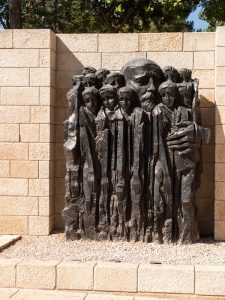
Herzl Museum
Herzl Museum is on Mount Herzl, and it commemorates the founder of Zionism, Theodor Herzl, who died in Austria in 1904, and whose relics were brought to Israel in 1949, the year after the establishment of the independence of the State of Israel, which is the only Jewish state in the world.
Herzl is also known in Hebrew as Chozeh HaMedinah, which means “Visionary of the State” of Israel in the sense of prophet of Israel. His body was buried in a freestanding sarcophagus on the summit of this hill, which was named after him. The Herzl Museum stands close to the main entrance, and it contains a reconstruction of Herzl’s study and library. In the large park, there are the graves of Herzl’s parents and many leaders of Zionism.

Summary of the review of historical places in Jerusalem
Hence, there is a lot to visit and explore in Jerusalem and in its surroundings. And, it is recommended to spend a week seeing most of the places that have been enlisted in this blog post. Enjoy your stay in Jerusalem, or if you are abroad, think well about organising a vacation in Israel, which is a real magical place.
